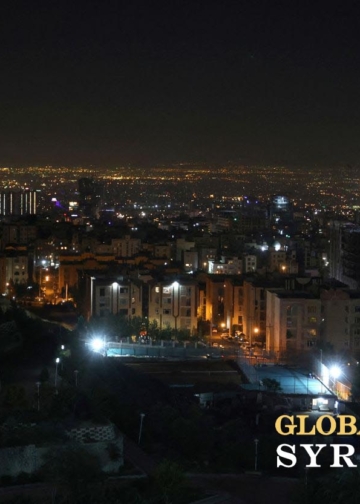Ibrahim AlJabin
There was talk years ago about an attack that was said to have been carried out by a young Syrian Arab man against (another) Syrian Jew in a German city, without the media providing detailed information proving this story. Such incidents, and the debate we are witnessing about the relationship between Arabs and Jews, make one think about such issues. I had written an article about that story, published in German in the German magazine Inter Kultur in the fall of 2017, and today the facts and questions contained in it are needed again with the events in Gaza and the daily violent bombing of civilians who are paying the price for both the foolish and deceitful decisions of politicians.
Targeting civilians is a crime, regardless of the party that carries it out, and whoever its victims, and it does not require legal experts to diagnose, as morals and human values reject it immediately and without hesitation. As for me personally, I was and still am finding it difficult to believe these stories that are being told, that Arabs can be hostile to Jews, and that they can create a state of bloody violence towards another just because he is Jewish.
In order to understand what is happening today, we have to look at history, specifically at World War I. At that time, a new political entity was emerging in the Middle East. Its name was the Kingdom of Syrian Arab Republic. The goal was independence.
The struggle for independence began with a group of Syrian Arab intellectuals who sought to create a national political movement to save Arab identity from loss. Concern over this identity was the result of a policy followed by the Ottoman Empire, namely “Turkification.” This policy consisted, among other things, of prohibiting the use of the Arabic language to many measures implemented by the Turkish federalists.
Influenced by German philosophy, the Arabs at that time drew up a national charter called the “Damascus Charter” and called for building a democratic state for all that would preserve their identity and civilization from extinction. Because of fear of Jamal Pasha, the assassin and governor of Damascus, who would lead a group of Syrian politicians in Damascus to the gallows in the middle of Marjeh Square in Damascus, they asked Faisal Ibn Sharif of Mecca to deliver the “Damascus Charter” to his British and French allies. As the details tell us, Faisal hid the manuscript of the Charter in his shoe and took it to Hijaz, where his father was.
A few years later, this Faisal returned as king of the “Kingdom of Syrian Arab Republic.” One of his first measures was to appoint Eliyahu Sasson as editor-in-chief of the first Arab national newspaper (“Al-Hayat”). Sassoon was a Jew from Damascus. At that time there was no hatred towards the Jews, as the West claims. They were all equal with a common national identity ; Jews, Muslims and Christians.
In addition to that, the works of Moses ibn Maimon, the Andalusian Jewish thinker, about whom many Jews say: « God has not yet created a Moses like Moses except Moses » were printed in Damascus. In doing so, they want to show that the importance of the thinker Moses ben Maimon can be compared to the importance of the Prophet Moses. In the Arab Islamic world, at that time and until this moment, Maimonides is still considered one of the Arab Muslim thinkers. This is how Arab Muslim thinkers classified him. And they said without hesitation that he was a Jew originally from Andalusia, from where he was exiled, at the hands of the Christian Western Spaniards, to North Africa with the Muslims and Jews who suffered from injustice in that country. Maimonides later became a doctor and minister in the state of Saladin Al-Ayyubi. On the other hand, he is considered one of the most important Jewish scholars and interpreters of the Torah, if not the most prominent among them.
The Arab Jews used to print the Qur’an
In the east, a five-hour drive from Damascus. Muslims used to read the Qur’an that was printed in Jewish printing press houses in Baghdad, such as that of the Iraqi rabbi Ezra Rubin Dankor. At that time and until the beginning of the twentieth century, only Jews owned printing houses. The Muslims in Baghdad had full confidence in these editions of the Qur’an. They were not anti-Judaism, as the West claims, and this is particularly evident in the entry of Sasson Ezekel into political life in the Kingdom of Iraq as the first Minister of Finance. In those days, the Iraqis had entrusted him with the entire wealth of the country.
That who searches for feelings of hatred against Jews in the roots of modern Arab culture will not find them until a little more than 100 years ago. The Arabs call themselves “Semitic” and in fact they are. On the other hand, Jews are also Semites. How can anyone be convinced that Arabs are hostile to themselves and their original identity? Especially since they know very well that the three religions (Judaism, Christianise, and Islam) come from their countries, that is, from the “Arabian Peninsula” as well as from what was known as the “Greater Levant.” For all this, such feelings did not exist at that time. Anti-Semitism developed. Indeed, in other places in the world, and from there it spread, as a problem and not as a state of awareness, to the Arab region and elsewhere.
Every time I study the history of Europe, especially the periods that preceded the Renaissance, my attention is clearly drawn to how cultural exchange occurred between civilizations; and every time I also find that this exchange had to be carried on a more important carrier for the people, namely commercial exchange.
In the Middle Ages, the Italian city of Venice was an important place of cultural transformation, based on exchange, where the cultures of the West and the East met. Thanks to that , the city later became one of the largest economic cities in the world, from which European goods were shipped to the Arabs and the entire East, and other goods were imported from the East. Through that city, the methods of commercial accounts in which the Arabs excelled, were transmitted, and from them were “Arabic numerals,” were taken and many of the origins of came to be known as “bookkeeping.”
Through these cultural and economic flows, that link different countries like rivers, religious sensibilities were also transmitted. Only later, after trade flourished, did Venice find itself confronted with these sensibilities. Among the taboos included in Christianity and Islam is usury. But in Judaism there is no such prohibition. Therefore Jews are allowed to participate in free trade.
At that time, most of the major merchants of the East and West were Muslims and Christians, respectively, and the prohibition of dealing in usury represented a major obstacle to their pursuit of greater profits. But for them the solution lay in religion itself. A merchant would have no choice but to find solutions from within regarding what was forbidden, and through the efforts they made and the interpretations they provided of the Bible and the Qur’an, they were allowed to practice free trade (with usurious interest) through an intermediary, and it was self-evident that that intermediary would be a Jew. As a result, some Jewish families accumulated huge profits, and resentment against them slowly began to grow.
These were the seeds of hatred that arose from the resentment of the poorer classes of Italian society towards the Jews, to whom wealth gradually began to be limited. This had nothing to do with the crucifixion of Christ or even with Jerusalem. This can be seen particularly clearly in the time of Elizabeth I, Queen of England, as this period was considered the peak of the Renaissance, or the Golden Age of English history as historians tend to describe it.
Shylock, the ugly symbol
On June 7, 1594, Rodrigo López, the personal physician, a Christian of Jewish origin, to Queen Elizabeth I of England, was sentenced to death by hanging. He was suspected of trying to poison the queen. Lopez denied this charge and said at the time that he “loves Queen Elizabeth as he loves Jesus Christ,” a statement that the judges ridiculed, considering it evidence of guilt rather than innocence. From that moment, anti-Semitism began to spread in Western Europe.
Through the flourishing of art and literature, anti-Jewish sentiment found its way to other countries in Europe. Shylock, the Jewish moneylender who appears as a main character in William Shakespeare’s play “The Merchant of Venice,” is the best example of the prejudices that were widespread against Jews in Europe at that time. Especially since it was first published on July 22, 1598, that is, only four years after the incident with Doctor Lopez.
It is certain that there were many other reasons for hatred at that time among all people, however, the above seems striking to me, because it shows how these feelings spread on both sides. On the other hand, this can be linked to the discrimination that the Jews faced under Christian rule in Andalusia, and what happened to the Jews in Venice, a city in which, for the first time in history, a closed area appeared in which the Jews had to live, forced, separate from the rest of the population.
It began with the migration of Jews from various European countries and even from the Arab and Islamic world in the thirteenth century AD, especially from Syria, to Venice because of the prosperity of life there and because of the possibility of finding business there, as previously mentioned. Then the Venetian rulers saw this as a threat to their authority, and so they forced the Jews to live in a closed residential area.
Where did the first Jewish ghetto appear?
The Jewish quarter in Venice was called a “ghetto,” which means something like “separation” or “divorce” in Italian. It was not long before the term ghetto later came to refer to any Jewish neighborhood around the world. It was not allowed to leave this isolated neighborhood except in the morning, on the condition that one wear clothes with certain characteristics that distinguish Jews from the rest of the population.
This tragic situation in the “Venetian Ghetto” continued until the reign of the French Emperor Napoleon Bonaparte in 1790, who personally demolished the walls of the ghetto in order to free the Jews. Israeli documents themselves show that the “ghetto” system was first implemented in Frankfurt in 1616. It originally resulted from an agreement between the city administration and the Jews. Then the same system was also established in Vienna in 1624.
Russia, on the other hand, had developed a system different from that which emerged in Western European countries. Jews were forced to live in certain areas of the country and were forced to remain in their original regions of Poland. This led to the establishment of a settlement area in 1775, which later became a large new “ghetto” under harsh conditions.
Here in Germany, in the atmosphere of the beginning of the twentieth century, and under a cunning desire to capitalize on popular anger over the deteriorating economic conditions, unemployment, and inflation, the Nazis worked to focus German thinking towards reasons other than politics and governance to explain the bitter reality, and they told the people that the reason for all of this was “the Jews”.
Hitler began gathering Jews in the “Dachau” camp, the first concentration camp established by the Nazis, outside Munich, in 1933. Before they established more than 40,000 camps in the areas they controlled, in which Jews were used to work with forced labor, which is a type of slavery. They were being prepared for extermination.
Just four years later on November 9, 1938, Germany witnessed a night called the “Night of Broken Glass”; because of the amount of shattered glass that covered the streets following the raids on Jewish stores and stores. That night, about 91 Jews were killed, 30,000 others were arrested, and 267 synagogues were destroyed.
The Nazis created what they called the “Final Solution,” which meant for them “the final elimination of European Jews,” and they began to accumulate Jews in concentration camps in Poland and elsewhere.
By the end of 1941, the Nazis established the first extermination camp in Poland, called Chelmno. Six extermination camps were also established in Nazi-controlled areas of Poland, the largest of which was Auschwitz, along with other camps in Belarus, Serbia, Ukraine, and Croatia, which witnessed the killing of hundreds of thousands.
Remember Isaac Deutscher
All this happened while the Jewish Quarter in Damascus was open and open to all. It is worth noting that the most famous craftsmen who made copper artifacts in Damascus are the Jews. Not only that, even the most prominent merchants and intellectuals were also Jews. One of them was Mr. Anbar, owner of the Anbar Office, the prominent school that graduated most of Damascus’s intellectuals until the early twentieth century.
what happened after that?
Itzhak Deutscher, the well-known Polish thinker who wrote the book “The UnJewish Jew,” describes the conflict between Arabs and Jews as follows: The story is like a two-story house. The second floor burned down. The resident (European Jew) who was on the second floor jumped to the first floor to escape the fire. But this was the land of the Arab population. While the one who jumped remained looking at the fire without noticing what his jump had caused, the other resident remained looking at the ground without thinking about anything else, except freedom from whoever was crouching above him.
After World War I, the victorious powers agreed that there was no need for peace between Arabs and Jews. There is a lot of evidence for this, but one piece of evidence is quite clear. In 1919, Faisal, King of Syria, concluded an agreement in Paris called the “Faisal-Weizmann Agreement” with Chaim Weizmann, head of the World Zionist Organization. That agreement specified peaceful coexistence and defined state borders in the region and was therefore considered a peace treaty. However, France and Britain, , for their part, worked hard to destroy that agreement. France occupied Syria and expelled King Faisal from Syria.
One of the ironies of this time is that one of its victims at the time was also an Arab-Jewish politician and intellectual whose name I mentioned above: Eliyahu Sasson. It was a great disappointment for him to see the dream of a democratic state in Syria completely destroyed. After everything collapsed, he decided to immigrate to Palestine, which was later called Israel. Sassoon became an important political figure there. He established major security stations and held prominent positions. Only there he lived his dream, not in Damascus, the city he loved.
During that period, the press in France was busy with demonstrations against the French occupation in many Syrian cities. Many images of demonstrators carrying crosses, crescents and the Star of David as a symbol of solidarity were broadcast. The photos are still preserved in the archives today. Anyone can look into it.
How did the European wars affect the rise of anti-Semitism?
The war in Europe had a major impact on the spread of so-called anti-Semitism. In particular, the mobilization of Arab soldiers and the creation of the so-called Arab Army Corps to fight within the Nazi SS in World War II played a decisive role in the spread of anti-Semitism in the Arab region.
The question is, how did the Jews become enemies of the independence process of Arab countries? This began with an opportunistic relationship between Hitler and Sheikh Muhammad Amin al-Husseini, who received an offer from Berlin to work with the Nazi regime. This ultimately led to the transformation of conflicts in the Middle East from conflicts between the foreign settler and the original landowner to a conflict of religions.
A conflict in which the Zionist agency participated in all the Arab governments that came to power in the countries that emerged after the ideological division of Greater Syria. The Jews became enemies of the Arab independence process, not enemies of Islam.
The expulsion of Jews first began in Egypt and Iraq. Anyone who did not leave the country voluntarily at that time found himself exposed to great pressure from both sides. On the one hand, Israel’s political class exerted pressure on the Jews. This class was well aware of what the major Western powers were aiming for in the Arab region. So it started playing right away. On the other hand, the Arab regimes tried to spread panic among the Jews. The Farhud incident in Iraq can be cited as an example of this.
On the other hand, anti-Jewish sentiments in Syria fell on deaf ears. The Jews remained in their cities, in Damascus, Aleppo, and Qamishli, and lived in peace like everyone else, Muslims and Christians. But they remained in the form of negotiating papers with the Assad regime, which the West bartered with them over the past decades in exchange for his regime’s continuity in power.
What began as a European-British promise embodied in the Balfour Declaration to the Jews to establish an alternative homeland (away from Europe) in Palestine, continued as an endless conflict, managed by the Europeans themselves, and behind them the United States.
In conclusion, I am firmly convinced that Arab political regimes are indeed anti-Semitic. As for the Syrians, they are certainly not anti-Semitic. They do not understand this language and it does not work in their mental structure. Syrian society is based primarily on diversity, but many wrong ideas have taken root in people’s minds and spread through manipulation practiced by authoritarian political regimes in the Arab region.
As for the West, it is still practicing the same hypocrisy in dealing with the Jewish issue, and it cannot prevent itself from exploiting it whenever it is forced to do so, pinning the blame on the Arabs and others, to purify itself of an ugly legacy that still dominates its mind. If the United States and the West were really serious in all their declarations about the desire for the Jews to live in peace, they would have imposed a two-state solution and ended the conflict in the Middle East, but this no longer deceives anyone, not even in Israel itself, where what is happening today may be Netanyahu’s last war, who is the heir of the first Israeli political class that invested in the conflict instead of being keen on resolving it on the basis of peace and justice for all.



















